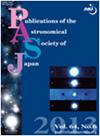Transition luminosities of Galactic black hole transients with Swift/XRT and NICER/XTI observations
IF 2.2
4区 物理与天体物理
Q2 ASTRONOMY & ASTROPHYSICS
引用次数: 0
Abstract
Abstract The X-ray spectral state transitions of Galactic black hole transients (GBHTs) are often linked to the changes in the mass accretion rate. A narrow distribution of transition luminosity in terms of the Eddington ratio has been found in previous studies of GBHTs based on RXTE data (Maccarone, 2003, A&A, 409, 697; Vahdat Motlagh et al., 2019, MNRAS, 485, 2744) and this Eddington ratio at the transition is often used in recent studies with instruments such as Swift/XRT and NICER/XTI, covering soft energies below 1 to 10 keV. However, the X-ray states characterized by spectral parameters may have different definitions depending on the energy ranges adopted in the spectral analysis, leaving the question of whether the distribution of transition luminosity obtained with RXTE remains the same when we use the instruments covering softer energy bands. In this work, we investigated the X-ray state evolutions and the variations of luminosities of eight outbursts of seven GBHTs. We found that the bolometric luminosity of the power-law component was tightly constrained to $\sim\! 1.3\%$ Eddington luminosity at index transition when the photon index starts to decrease towards the hard state, which is consistent with the previous RXTE results (Vahdat Motlagh et al. 2019, MNRAS, 485, 2744; Kalemci et al. 2013, ApJ, 779, 95). Moreover, the tightest clustering was found to be the power-law luminosity right after the start of disk recession, with a mean logarithmic Eddington ratio of −1.84 ± 0.28. In addition, our results suggest that the disk recession starts after the bolometric disk luminosity drops below 1% Eddington luminosity.用Swift/XRT和NICER/XTI观测银河系黑洞瞬变的过渡光度
银河系黑洞瞬态(GBHTs)的x射线光谱状态跃迁通常与质量吸积速率的变化有关。先前基于RXTE数据的GBHTs研究发现,从Eddington比值来看,过渡光度的分布很窄(macarone, 2003, A&A, 409,697;Vahdat Motlagh et al., 2019, MNRAS, 485, 2744),在最近的研究中,经常使用Swift/XRT和NICER/XTI等仪器,覆盖1至10 keV以下的软能量。然而,根据光谱分析中所采用的能量范围,光谱参数表征的x射线状态可能有不同的定义,这就留下了一个问题,即当我们使用覆盖较软能带的仪器时,RXTE获得的跃迁光度分布是否保持不变。在这项工作中,我们研究了7个gbht的8次爆发的x射线状态演变和光度变化。我们发现幂律分量的热光度被严格限制在$\sim\!1.3\%$ Eddington在光子指数开始向硬态下降时的指数跃迁光度,这与之前的RXTE结果一致(Vahdat Motlagh et al. 2019, MNRAS, 485, 2744;Kalemci et al. 2013, ApJ, 779, 95)。此外,发现最紧密的聚类是在盘衰退开始后的幂律光度,其平均对数Eddington比为- 1.84±0.28。此外,我们的研究结果表明,盘的衰退开始于热光度低于1%爱丁顿光度的时候。
本文章由计算机程序翻译,如有差异,请以英文原文为准。
求助全文
约1分钟内获得全文
求助全文
来源期刊

Publications of the Astronomical Society of Japan
地学天文-天文与天体物理
CiteScore
4.10
自引率
13.00%
发文量
98
审稿时长
4-8 weeks
期刊介绍:
Publications of the Astronomical Society of Japan (PASJ) publishes the results of original research in all aspects of astronomy, astrophysics, and fields closely related to them.
 求助内容:
求助内容: 应助结果提醒方式:
应助结果提醒方式:


